Marilyn Hamilton's Blog, page 47
May 8, 2017
Urban planners get new tool for building sustainable, smart cities
May 9, 2017–Vancouver, BC and Tuscon, AZ–Marilyn Hamilton, the foremost expert on integral city planning and Integral Publishers, the first publishing house dedicated to publishing works on integral, transdisciplinary approaches, have launched the second book in the Integral City book series, Integral City Inquiry & Action: Designing Impact for the Human Hive. The book is a veritable how-to guide for urban planners and change workers on how to engage citizens, communities and collectives to build sustainable, resilient cities of the future. The launch is timely as large and small cities around the world increase budgets for these roles and services.
Integral City Inquiry & Action is the second book in a four part series published by Integral Publishers. The first book, Integral City: Evolutionary Intelligences for the Human Hive, is an overview of the 12 intelligences needed to build integral cities, whereas book two is the how-to guide for placemaking and, equally as important, “placecaring,” a term coined by Hamilton in the book. Book one will be re-released by Integral Publishers this summer with an updated introduction, while books three and four will be released over the next two years.
Praise for the new book comes from experts like Ken Wilber, one of the most widely read and influential American philosophers of our time, Lisa Norton, design professor and associate dean at Parsons School of Design, and more. To see the full list of reviews please visit this link.

What Integral City tells us, among numerous important specific insights, is that any approach that is less comprehensive or less integral is doomed to failure, because only an integrally pluralistic theory and practice will cover all the truly important bases. My congratulations to the author for another profound, timely, and superb work! Ken Wilber— Philosopher, Integral Theorist, Author: The Integral Vision; Sex Ecology & Spirituality; Integral Psychology; A Brief History of Everything
This leading edge and thoroughly practical contribution to inquiry and impact on the crucial dilemmas faced by cities today, is a gift to next generation urban change workers. Lisa Norton, Professor of Design Leadership and Associate Dean, School of Design Strategies, Parsons School of Design, New York, NY
“Integral City Inquiry & Action is a book for the placemakers and placecarers who are creating the cities of our future,” said Hamilton. “I wanted to provide an actionable resource not just for the chief resilience officers in the world’s largest cities, but for the thousands of small to medium cities where change agents, the building industry, students studying to become placemakers, city workers, social workers, designers and more can learn from our models, tools and practices.”
“It is an honor to publish smart, thoughtful and desperately needed works like this one by Marilyn Hamilton – it’s really why we do what we do at Integral Publishers,” said Russ Volckmann Co-Founder at Integral Publishers, LLC. “We are thrilled to bring the full four-book series to print and know that it will add great value to our diverse catalog of ground breaking and thought provoking books and authors.”
Integral City Inquiry & Action is available for purchase through Amazon.com and is available for students of Integral City training on Integralcity.com. The list of books by Marilyn Hamilton can be found here. Key resources featuring her work can be found here.
About Marilyn Hamilton
Dr. Marilyn Hamilton, founder of Integral City Meshworks and author of the Integral City Series of books is an “AQtivator.” She convenes the 4+ Voices of human hives to transform their habitats into Gaia’s Reflective Organs.
About Integral City
Integral City Meshworks is a global constellation of communities of practice that nurtures cities as human hives. Launched in 2005, and now in Canada, USA, Netherlands, Russia, Mexico and South Africa we connect the 4 Voices of the city to energize relationships, that unify visions and develop eco-regional resilience strategies for human hive wellbeing. Through placecaring and placemaking we inspire a Planet of Integral Cities as living, integral, evolutionary human systems, to become Gaia’s Reflective Organs.
About Integral Publishers
Integral Publishers is the first publishing house dedicated to publishing the works by authors who draw on Integral, Adult Development, Complexity, Interdisciplinary, and Transdisciplinary approaches. A channel for integrally-informed, leading edge thinkers to bring their ideas to as wide an audience as possible in the service of the greater good. Integral Publishers also owns Tangent Publishers, that promotes exceptional works by outstanding authors that do not necessarily fall within the Integral, Adult Development, Complexity, Interdisciplinary, and Transdisciplinary approaches, and Integral Leadership Review, an online journal dedicated to the work by theorists and practitioners of integral theory relating to all levels of Leadership.
May 4, 2017
Collective Impact Aligns Strategic Planning with Placecaring & Placemaking KSF’s
Imagine Durant has drafted a working Vision. They are at a stage where that Vision will continue to be refined and wordsmithed. But it captures enough of the intentions of the last 3 years of Dialogue that three strategic themes have emerged.
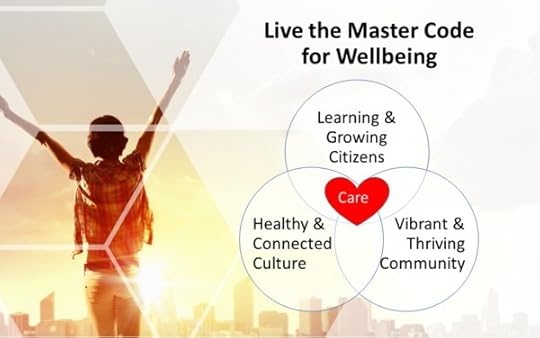
1.Learning & Growing Citizens through:
Growing (participation)
Educating (to world-class level)
Developing (all generations
2. Healthy & Connected Culture through:
Living (healthy, mature complete communities)
Playing (connecting through sports, arts, faith, food)
Wellbeing (improving quality of life)
3. Vibrant & Thriving Community through:
Vibrant (infrastructure and economy)
Thriving (encouraging small business and workforce development)
Pride (engaging community for personal expression, and collective enrichment)
Much to the delight of the Imagine Durant Board they discovered that their trio of themes aligns beautifully with the Master Code: caring for Self, Others, and Place.
But also, the Board has reviewed the Formative Outcome measures that are captured in Integral City’s update to its assessment of the 12 Intelligences. And happily we all discover that progress has been made in the last 4 years in every one of the sets of Intelligences.
Moreover, the strategically minded Board is working in smaller groups to identify specific objectives, what collectives should take collaborate to achieve results and who might be the leaders. These specific outcomes are also being connected to measures for Summative Outcomes for effective Placecaring and Placemaking, in the form of Key Success Factors (KSF’s).
So, the bottom line for Imagine Durant in 2017, is that by coming full circle from their intention to build on their capacities for Place Caring by matching them with capacities for Place Making, is that they are collectively engaged in Living the Master Code. Thus, Imagine Durant is collectively making impact for this generation and generations to come. And that surely, that recipe for Wellbeing in their Human Hive is the ultimate KSF of their success?

This blog series celebrates the launch of Book 2 in the Integral City Book Series: Integral City Inquiry & Action: Designing Impact for the Human Hive.
In this blog series, we share a case study that we presented at Tamarack’s Collective Impact 3.0 conference to tell you how Imagine Durant has used the Integral City Placecaring & Placemaking tools for the Human Hive.
The series includes:
Imagine Durant Impact Models Placecaring & Placemaking in the Human Hive
Integral City Tools Connect Outer Space to Inner Space
What is Your Role in the Human Hive?
Collective Change: Roles of AQtivator & Integrator
Integral City Designs for Collective Impact
Stories Bring Collective Impact Alive: Create an Outcome Feedback Loop
Collective Impact is Inspired by Early Win like Nowa Oka Trail
Collective Impact Calls Forth Long Term Horizons
Collective Impact Aligns Strategic Planning with Placecaring & Placemaking KSF’s
Collective Impact Calls Forth Long Term Horizons
With a process and a project like Imagine Durant, collective impact calls forth civic engagement in the present. But it also calls for a picture of a longer-term impact.
The Integral City Book 1 is dedicated to the 7th generation from now – a horizon line adapted from the First Nations peoples who invoke this consideration when making any decisions – how will the consequences of our actions impact 7 generations hence?
Imagine Durant set a more modest horizon line to plan forward – and realize the values they have discovered and wish to build on. Imagine Durant’s Value Realization time line reaches out for 30 years.
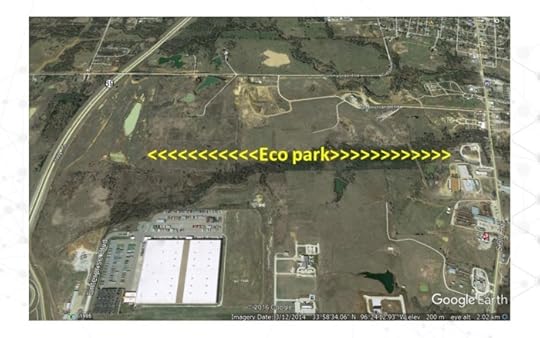
Even 30 years of imagined change requires some critical “pivots” from how the city currently is configured. The key pivots that have come up for discussion include:
Transforming a park on the northwest edge of town into “Central Park”
Developing new housing in current brownfields to meet the workforce housing demands of the thriving economy
Converting brownfield/waste land into an Eco-Park – with connections to watersheds and swales
Redrawing the city boundaries to align with expanded school district boundaries.
Each of these pivots demands foresight, commitment and inspiration from a unified vision to energize and release the resources of space, time and people for the next generation. But without a Vision, the people perish – and Imagine Durant is keeping Vision, People and Strategy alive.
This blog series celebrates the launch of Book 2 in the Integral City Book Series: Integral City Inquiry & Action: Designing Impact for the Human Hive.
In this blog series, we share a case study that we presented at Tamarack’s Collective Impact 3.0 conference to tell you how Imagine Durant has used the Integral City Placecaring & Placemaking tools for the Human Hive.
The series includes:
Imagine Durant Impact Models Placecaring & Placemaking in the Human Hive
Integral City Tools Connect Outer Space to Inner Space
What is Your Role in the Human Hive?
Collective Change: Roles of AQtivator & Integrator
Integral City Designs for Collective Impact
Stories Bring Collective Impact Alive: Create an Outcome Feedback Loop
Collective Impact is Inspired by Early Win like Nowa Oka Trail
Collective Impact Calls Forth Long Term Horizons
Collective Impact Aligns Strategic Planning with Placecaring & Placemaking KSF’s
Collective Impact is Inspired by Early Win like Nowa Oka Trail
When Imagine Durant embarked on it first Thought Leader Dialogue with the 4 Voices on the topic of Economy & Community they discovered the power of the Early Win.
From the explorations of what was working around here, what was not working and what people envisioned for the future, participants discovered a shared longing.
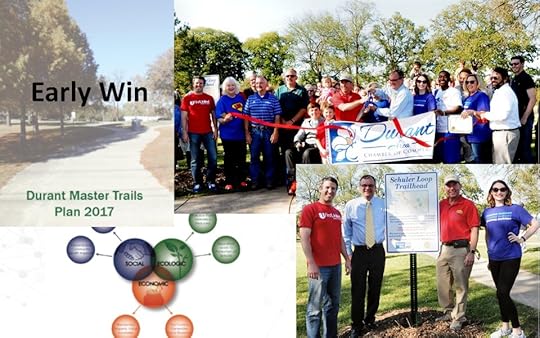
Everyone wanted a safe, accessible and enticing walking trail. The rapid growth of the city had somehow missed out on the connections of sidewalks, streets, country trails and university paths. But everyone of all cultures, ages, genders and communities agreed on the need and value of such a trail.
So out of the discovery of this shared longing, was born the idea of selecting the walking trail as an “Early Win”. In any project, an “early win” can become a model or prototype and an inspiration for the rest of the project. It assures people that something is happening and invites them into engaging in the project.
With Imagine Durant, the Executive Director along with several Board Members, Thought Leaders and a participant at the first Public Dialogue created an ad hoc committee to consider how to create a walking trail for Durant. Within 6 months the ED had written her first grant application to the National Parks Service to access their services for developing a plan for the trails project. Within months of submitting the application the committee learned of their success at receiving the grant and they organized the visit from the National Parks Planner.
Before long, the trail had a name: the Nowa Oka Trail – which is Choctaw for “Water Walk” – capturing both the intention to create a trail that followed Durant’s natural water courses and the indigenous culture in the name. The ad hoc committee quickly transformed into a standing committee with a Chair (that eager participant from the first Public Dialogue) and a format for a Plan-to-Plan.
The Early Win project then selected its own early win by opening a section of the trail connected to the campus Southeastern Oklahoma State University – the Shuler Loop – to great acclaim and appreciation of the public who turned out for the official opening.
Encouraged by their early success, the committee has gone on to submit another grant application to the organization supporting the re-purposing of old rail beds – and received a grant (worth several hundred thousand dollars) to build a pedestrian bridge along the old rail line. Not only that but the committee has moved to assist the City to contribute its required share of the funding by setting up a crowdfunding process to collect the money.
This ongoing example of the Early Win of the Nowa Oka trail has had a major collective impact on Durant. It has demonstrated the sincerity and commitment of Imagine Durant to not only create a unifying Vision for the city but also the strategies to implement it.
This blog series celebrates the launch of Book 2 in the Integral City Book Series: Integral City Inquiry & Action: Designing Impact for the Human Hive.
In this blog series, we share a case study that we presented at Tamarack’s Collective Impact 3.0 conference to tell you how Imagine Durant has used the Integral City Placecaring & Placemaking tools for the Human Hive.
The series includes:
Imagine Durant Impact Models Placecaring & Placemaking in the Human Hive
Integral City Tools Connect Outer Space to Inner Space
What is Your Role in the Human Hive?
Collective Change: Roles of AQtivator & Integrator
Integral City Designs for Collective Impact
Stories Bring Collective Impact Alive: Create an Outcome Feedback Loop
Collective Impact is Inspired by Early Win like Nowa Oka Trail
Collective Impact Calls Forth Long Term Horizons
Collective Impact Aligns Strategic Planning with Placecaring & Placemaking KSF’s
Stories Bring Collective Impact Alive: Create an Outcome Feedback Loop
Designing for collective impact effectively means that Integral City teams are always paying attention to how we speak with one another. That is why we start off with agreements forms for Consent to Participate and guidelines for respectful dialogue. (We include the Guidelines for Respectful Dialogue with every Agenda and print them on the back of the Executive Directors business card – so that we make them contagious throughout the city.)
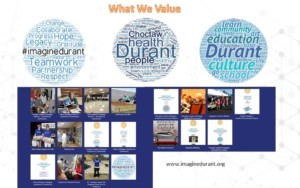
Designing for collective impact, also means that during any meeting we designate the role of “scribe” to more than one person so that the stories do not get lost in the excitement.
We believe that, “People need stories more than food to stay alive.” (Barry Lopez)
Integral City creates a design team with an intention to capture the stories from the beginning to the end and create a report that can be shared with the whole city.
We look for a local scribe who will record (on the computer, in writing or by audio or video recording) the stories that people tell.
In small groups our team brings professional facilitators and/or trains local participants to record small group conversations on flipcharts. The collection of flipcharts is then organized after the event and given to the local scribe as input into the report that she/he curates.
Integral City assigns an editor to review the report and keep multiple reports consistent in format and aligned in intention.
With Imagine Durant, the Executive Director also played an important role in sending the draft reports back to the participants for their approval – because our reports will be published on the Imagine Durant (and Integral City) websites.
Not only that, but the Executive Director also negotiates with the community newspaper to have the Thought Leader reports published in special editions and circulated to all households in the city.
The collecting, curating and communicating of the stories from our dialogues, mean that we create a self-energizing feedback loop that assures participants that they were heard and reaches out to include those who could not attend.
With Imagine Durant, their website and Facebook pages further amplified their many activities and continuously tied together the multiple themes they explored in search of a unifying Vision.
This blog series celebrates the launch of Book 2 in the Integral City Book Series: Integral City Inquiry & Action: Designing Impact for the Human Hive.
In this blog series, we share a case study that we presented at Tamarack’s Collective Impact 3.0 conference to tell you how Imagine Durant has used the Integral City Placecaring & Placemaking tools for the Human Hive.
The series includes:
Imagine Durant Impact Models Placecaring & Placemaking in the Human Hive
Integral City Tools Connect Outer Space to Inner Space
What is Your Role in the Human Hive?
Collective Change: Roles of AQtivator & Integrator
Integral City Designs for Collective Impact
Stories Bring Collective Impact Alive: Create an Outcome Feedback Loop
Collective Impact is Inspired by Early Win like Nowa Oka Trail
Collective Impact Calls Forth Long Term Horizons
Collective Impact Aligns Strategic Planning with Placecaring & Placemaking KSF’s
Integral City Designs for Collective Impact
When Integral City works with a city like Durant, we design with a framework based on Values and the 4 Voices of the Human Hive.

Our methodologies are designed around the principles for collective impact embedded in:
Appreciative Inquiry
Action Research
The 4 Voices include the Citizens, Civil Society, Civic Managers and Business. But we also seek contributions from the 4 Voices through other dimensions, including:
Multiple generations.
Multiple Cultures – such as in Durant, the Choctaw Nation and the many lineages of other American cultures.
All genders.
Integral City Values Assessments are designed to collect data on the Quality of Life in the city through discovering people’s Values, Actions, Visions and Systems. We collect the data from individuals, based on the key questions that release the potential of the city. Then we are able to analyze it into the 4 Quadrants that align the Quality of Life and the 4 levels of complexity that people value in the city (which are based on the Master Code):
Self-centric – which shows up as care for Self
Other-centric – which shows up as care for Others
Place-centric – which shows up as care for Community or City
Planet-centric – which shows up as care for Planet
Dialogue plays an important role in Integral City designs because it brings the whole system into the conversation about change. We design for multiple rounds of Dialogue to bring different collectives together around core themes of city change.
In the case of Imagine Durant, after our first Discovery Round of Dialogue we embarked on 3 Rounds Dialogue focused on 3 Themes:
Economy & Community
Health & Environment
Education & Culture
Each of these Dialogue Rounds included 3 types of participants:
Thought Leaders (purposively invited from the 4 Voices and related to the Themes)
Public
Policy Makers
In addition, in order to make the Dialogues as accessible as possible we situated each gathering in a different location – including the museum, the high school, the Choctaw community centre, the casino, the art gallery at the university, and the Food Bank.
Importantly, local sponsors donated space, accommodations, food and beverage and volunteers to work at the events and ensure they are well run.
When people gathered, they had received an invitation, were registered and taught the basic guidelines for Dialogue. Then the Integral City Team facilitated the discussions using Collective Impact Methods such as Open Space, World Café, Circling, Art of Hosting.
As a result of designing from assumptions about the wholeness of the City (aka human hive), collective impact becomes a natural outcome from the very first invitation and offer to engage, to the last word recorded and scribed into a report for collective sharing. (Check out the next blog for an explanation of how we design the process of communicating results.)
This blog series celebrates the launch of Book 2 in the Integral City Book Series: Integral City Inquiry & Action: Designing Impact for the Human Hive.
In this blog series, we share a case study that we presented at Tamarack’s Collective Impact 3.0 conference to tell you how Imagine Durant has used the Integral City Placecaring & Placemaking tools for the Human Hive.
The series includes:
Imagine Durant Impact Models Placecaring & Placemaking in the Human Hive
Integral City Tools Connect Outer Space to Inner Space
What is Your Role in the Human Hive?
Collective Change: Roles of AQtivator & Integrator
Integral City Designs for Collective Impact
Stories Bring Collective Impact Alive: Create an Outcome Feedback Loop
Collective Impact is Inspired by Early Win like Nowa Oka Trail
Collective Impact Calls Forth Long Term Horizons
Collective Impact Aligns Strategic Planning with Placecaring & Placemaking KSF’s
Collective Change: Roles of AQtivator & Integrator
When a city accepts an Integral City proposal we seal our agreement with a contract.
As team leader, I consider my role as AQtivator to be both a catalyst whose main job is to develop capacities for both Placecaring and Placemaking in the human hive and an aligner of the capacities with resources to discover a unified Vision with strategies to achieve it.
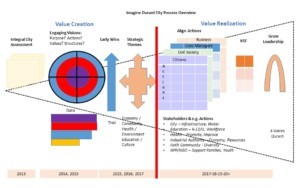
Our contract between Integral City and the city organization, sets out the overview of the change process that will unfold over the coming years. The first few years concentrate on Placecaring and Value Creation followed by a much longer period of Placemaking and Value Realization.
We use Logic Models to document all the outcomes and deliverables over a multi-year period.
Initiatives lead by the 4 Voices of the City – in places like Durant, Oklahoma – generally create an NFP like Imagine Durant, and a Formation Team to see them through the first stages of engaging energy and direction from all 4 Voices of the city.
The Formation Team (with Integral City guidance) then typically recruits sand selects an Executive Director and forms a Board. In Durant’s case, the team selected Kara (Hendrickson) Byrd as their Executive Director. Kara came into Imagine Durant at the very beginning – before the first Board had even convened – ready act as Integrator for the grassroots organization, and to meet any and all challenges she encountered. She wanted to make change not just in herself, but in her community – even in this case discovering she would have to “lay the path as she walked on it”. Quickly, she learned that learning was one of her major challenges and that she would have to share that learning with the Board, the 4 Voices and in many other collectives in the city to achieve the impact Imagined by the new Durant grassroots organization.
I interviewed Kara at the end of April 2017, to find out about her experience as Integrator of Collective Impact in her community, through her role as Executive Director over the last 2-3 years with Imagine Durant.

Below are the questions I asked her – the interview can be heard by clicking here:
http://integralcity.com/wp-content/uploads/2017/05/kara-audio_only.m4a
I must say that it has been a major satisfaction as AQtivator of Imagine Durant to collaborate with Kara Byrd as Integrator of Imagine Durant. I have watched her grow her leadership capacities and diligently and elegantly express the intentions of the 4 Voices of the city in ways that truly inspire Collective Impact – not just in working with the 4 Voices of the Board, but in the 4 Voices of the whole hive.
As Kara, courageously asserts, it has not all been an easy path – but, “When there is no challenge there is no change.” In her role as Integrator aka Executive Director, Kara has become not just a changemaker – but a Placecarer and Placemaker. Not surprisingly, in 2016 she was recognized as an Oklahoma 30 Under 30 Leader for NFP!!
Questions for Kara Byrd, Executive Director Imagine Durant
Background & Intentions
What attracted you to Imagine Durant?
What kind of impact did you think you could have?
How did your background with County Health help you to get started as an ED?
ED Role & Relationships
How do you describe your role as ED?
How do you describe the purpose of Imagine Durant?
Who is on your Board & how did they get recruited & selected?
How do you work with Integral City Team & Leader?
How have you connected to the 4 Voices of the City?
Why is it important to have 4 Voices at the table?
How have the 4 Voices generated impact in the city?
What has your role been in initiating and shaping the Dialogues?
How did you identify and access Thought Leaders, Public, Policy Makers?
Tell us about the Early Win Nowa Oka Trail Project
Why was it important to have an Early Win
What has been the impact of the Nowa Oka Trail on Durant?
What role are you playing as Imagine Durant moves from Visioning & Valuing into Realization & Strategy Execution?
What has been your greatest challenge as ED?
What has been your most valuable learning about achieving collective impact?
This blog series celebrates the launch of Book 2 in the Integral City Book Series: Integral City Inquiry & Action: Designing Impact for the Human Hive.
In this blog series, we share a case study that we presented at Tamarack’s Collective Impact 3.0 conference to tell you how Imagine Durant has used the Integral City Placecaring & Placemaking tools for the Human Hive.
The series includes:
Imagine Durant Impact Models Placecaring & Placemaking in the Human Hive
Integral City Tools Connect Outer Space to Inner Space
What is Your Role in the Human Hive?
Collective Change: Roles of AQtivator & Integrator
Integral City Designs for Collective Impact
Stories Bring Collective Impact Alive: Create an Outcome Feedback Loop
Collective Impact is Inspired by Early Win like Nowa Oka Trail
Collective Impact Calls Forth Long Term Horizons
Collective Impact Aligns Strategic Planning with Placecaring & Placemaking KSF’s
What is Your Role in the Human Hive?
One of the most beautiful opportunities that Durant offers is that it is what the astrophysicists (who are looking for earth-like planets in the universe) call a “Goldilocks” size. Durant is just the right size to be able to work with the whole city system in the room – not too big and not too small – just right to see the whole system in action.
One way that Integral City views the human system at the scale of the city is to think about it as a human hive – like the beehive is for the honey bee.

Let me pause and tell you a little bit about the honey bee so that we can borrow some of its incredible intelligence for our use.
An image of wholeness like the bee hive helps us imagine the city as a whole – without getting lost in the enormous scale and complexity of the city.
Apis mellifera – the honey bee has figured out a system that enables Placecaring behavior that enables the functioning of the hive – and also Placemaking behaviours that enables renewable resources for the entire eco-region of the hive.
Bee hives use 4 internal roles that enable sustainability. The Forager-Producers and Diversity Generators locate and gather pollen and nectar as raw materials for making honey. Resource Allocators and Inner Judges (or Integrators) work like a hive intelligence to determine if the hive will meet its annual production targets (about 20 kg of honey per year) and adapt to environmental changes.
Bees have sophisticated ways of communicating – with their waggle dance to indicate flower sources. They also use performance rewards to encourage productive behavior and measure pheromones to learn when they should change behaviors. (FYI forager bees are cut off from their rewards when they don’t perform, and this causes them to become depressed – a condition researchers can measure through pheromones. This drop in their “happiness indicator” causes a shift in their foraging behaviours to find new productive energy sources). So, by these means of setting targets, making course corrections and rewarding productive behavior honey bees create a double sustainability loop that directly contributes to Placecaring survival for the hive and Placemaking resilience for the eco-region.
(Incidentally, the bees utilize a fifth external role that contributes to resilience. It is called inter-group competition – and it comes from other bees competing for resources in the same territory, setting up the conditions for continuous improvement.)
The intelligence of the beehive – evolved over 100 million years is constantly being developed. It is expected that even the fateful and dangerous Colony Collapse Disorder will eventually be solved by the bees themselves who respond to both internal and external indicators in their habitat – and have in the past already solved CCD multiple times.
When I am discerning the lessons of the beehive I am particularly struck by the similarities between the 4 roles of the beehive and the 4 Voices of the human hive (or Integral City).
This is how I see the connections between the roles in the bee and human systems:
Forager Producers are Citizens
Diversity Generators are Business
Resource Allocators are Civic Managers
Inner Judges (Integrators) are Civil Society
When you are looking at your city, the next time, consider it as the Human Hive and ask yourself, What roles do you play most often?
This blog series celebrates the launch of Book 2 in the Integral City Book Series: Integral City Inquiry & Action: Designing Impact for the Human Hive.
In this blog series, we share a case study that we presented at Tamarack’s Collective Impact 3.0 conference to tell you how Imagine Durant has used the Integral City Placecaring & Placemaking tools for the Human Hive.
The series includes:
Imagine Durant Impact Models Placecaring & Placemaking in the Human Hive
Integral City Tools Connect Outer Space to Inner Space
What is Your Role in the Human Hive?
Collective Change: Roles of AQtivator & Integrator
Integral City Designs for Collective Impact
Stories Bring Collective Impact Alive: Create an Outcome Feedback Loop
Collective Impact is Inspired by Early Win like Nowa Oka Trail
Collective Impact Calls Forth Long Term Horizons
Collective Impact Aligns Strategic Planning with Placecaring & Placemaking KSF’s
Integral City Tools Connect Outer Space to Inner Space
When we first visited Durant in 2013 we asked for a tour of the city. That gave us a feel for the outer space of the city – its geography, built city and economy.

But more importantly we organized with our Tour Guide 4 ways to get to know the inner space of the city using these tools:
Meeting the 4 Voices of the City
Asking 4 Questions that Release Potential in a City
Guidelines for Dialogue
12 Intelligences Observations
The 4 Voices are a way to bring the whole city system into the room. I asked to meet 3 representatives from these Voices: Citizens, Civil Society, Civic Managers and Business.
In order to start our dialogue, we shared the Guidelines for a Generative Dialogue so that everyone’s voice could be heard. And with this process, we planted the seed for a succession of 9 dialogues to follow.

We gathered in a dialogue circle in the Library. In less than 2 hours I asked 4 key questions and learned for Durant:
What works around here?
What doesn’t work around here?
If you were Mayor for a day and could change anything, what would you change?
How would you describe your community and yourself?
Finally, after engaging with the streets and the people of Durant, I used a assessment that summarized the key observations that I had made of Durant in terms of the 12 Integral City Intelligences:
Contexting Intelligences: Ecosphere, Emerging, Integral, Living
Individual Intelligences: Inner, Outer
Collective Intelligences: Social (Structural-Systems), Cultural (Storytelling)
Strategic Intelligences: Inquiry, Meshworking, Navigating
Evolving Intelligences: (the energetic impulse that drives all the other intelligences)
What did Integral City discover about Durant when this “due diligence” was completed? We discovered that we were attracted to one another, and naturally moved from a stage of courtship to “marriage” with the drafting of a Proposal.
That Proposal set out the process by which Integral City would bring its frameworks to build on Durant’s natural expression of Placecaring by engaging all 4 Voices to create a unified Vision for the city and to build Placemaking capacities by developing the strategies to implement it.
This blog series celebrates the launch of Book 2 in the Integral City Book Series: Integral City Inquiry & Action: Designing Impact for the Human Hive.
In this blog series, we share a case study that we presented at Tamarack’s Collective Impact 3.0 conference to tell you how Imagine Durant has used the Integral City Placecaring & Placemaking tools for the Human Hive.
The series includes:
Imagine Durant Impact Models Placecaring & Placemaking in the Human Hive
Integral City Tools for Connecting Outer Space to Inner Space
What is Your Role in the Human Hive?
Collective Change: Roles of AQtivator & Integrator
Integral City Designs for Collective Impact
Stories Bring Collective Impact Alive: Create an Outcome Feedback Loop
Collective Impact is Inspired by Early Win like Nowa Oka Trail
Collective Impact Calls Forth Long Term Horizons
Collective Impact Aligns Strategic Planning with Placecaring & Placemaking KSF’s
May 3, 2017
Imagine Durant Impacts Collective Placecaring & Placemaking in the Human Hive
It’s time to share the story of Imagine Durant with a wider audience. Tamarack Institute’s Conference, Collective Impact 3.0 on May 9-11, 2017 will give me a chance to tell the story of collective impact through the lives of Imagine Durant’s leaders, Executive Director and 4 Voices of the city.

Imagine Durant has a history of what I call Placecaring – nurturing conscious Intentions and Values and Vision. And over the last 4 years it has focused the meaning of Placecaring on creating a unified Vision. But what is more – Imagine Durant has energized this focused Placecaring with strategic Placemaking – developing the actions and systems to implement their unified Vision.
Durant is located in the southeast corner of Oklahoma, about 1.5 hours north of Dallas, Texas. It has a population of about 16k on a normal day and more than 50k on an event day. For a seemingly small city it has impressive assets and resources that generate a thriving economy: the Choctaw Casino Resort, Oklahoma Shakespearean Festival and Southeastern Oklahoma University. Plus it boasts an Alliance Hospital, first class highschool, and police and fire facilities. Durant has a habit of capturing rewards – like the Promise Zone – and producing leaders like Oklahoma Teacher of the Year, Entrepreneurs of the Year, 30 under 30 NFP Leader.
The story of Imagine Durant started in 2013 with 2 leaders of the city – one who is now the Chief of the Choctaw Nation and the other who is President of First United Bank. Chief Gary Batton and President Greg Massey had been investing in leadership training for themselves and organizational development for their organizations. They asked: “What would happen if we made these investments at the scale of the city? Could we pay forward our learnings to the city we love and appreciate?”
In the process of answering that question they invited Integral City to visit and make some suggestions for how to move forward.
In October 2013, I made a Discovery Tour of Durant to survey its potential for change.
We used several tools to learn about Durant’s Placecaring and Placemaking potential:
Meeting the 4 Voices of the City
Asking 4 Questions that Release Potential in a City
Guidelines for Dialogue
12 Intelligences Observations
In the blog series that follows, we focus on our presentation at Tamarack’s Collective Impact 3.0 conference to tell you how these tools have contributed to Placecaring & Placemaking in the Human Hive called Durant, Oklahoma.
Marilyn Hamilton's Blog
- Marilyn Hamilton's profile
- 3 followers



